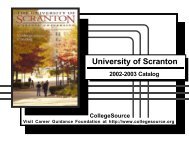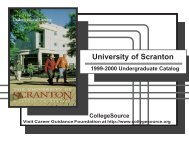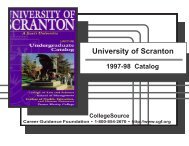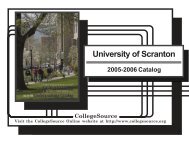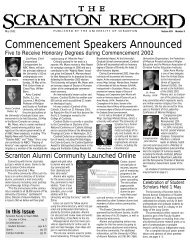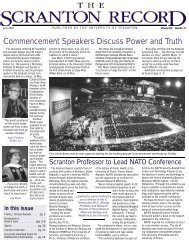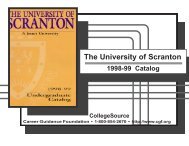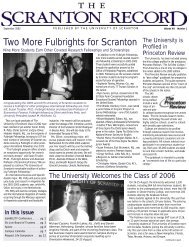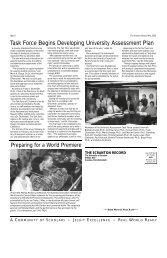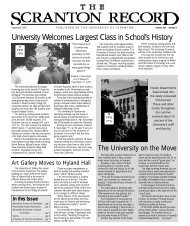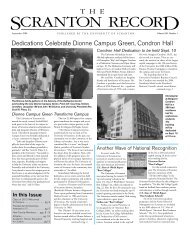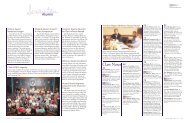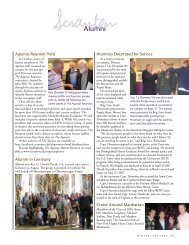2003-2004 - The University of Scranton
2003-2004 - The University of Scranton
2003-2004 - The University of Scranton
Create successful ePaper yourself
Turn your PDF publications into a flip-book with our unique Google optimized e-Paper software.
262 Panuska College/Exercise Science and Sport<br />
EXERCISE SCIENCE<br />
AND SPORT<br />
Faculty<br />
Gary N. Wodder, Ph.D., Chair<br />
Robert M. Bessoir, M.Ed.<br />
Ronald W. Deitrick, Ph.D., Program Director<br />
<strong>of</strong> Exercise Science<br />
Curt Dixon, Ph.D.<br />
David A. Hair, M.Ed.<br />
John S. Hopkins, M.S.<br />
Stephen L. Klingman, M.S.<br />
John B. Robertson, M.A.<br />
J. Michael Strong, M.S.<br />
Overview<br />
<strong>The</strong> Department <strong>of</strong> Exercise Science and<br />
Sport consists <strong>of</strong> three areas: a major in Exercise<br />
Science, a minor in Coaching and physical<br />
education activity classes.<br />
Exercise Science Major<br />
Exercise Science is the study <strong>of</strong> human<br />
movement as related to exercise, sport, and<br />
physical activity. It is dedicated to promoting<br />
and integrating scientific research and education<br />
on the effects and benefits <strong>of</strong> exercise,<br />
and to the delivery <strong>of</strong> physical-activity programs<br />
that prevent disease, facilitate rehabilitation,<br />
promote health, and enhance human<br />
performance. Exercise Science is part <strong>of</strong> the<br />
field <strong>of</strong> Sports Medicine which also includes<br />
clinical areas <strong>of</strong> study. <strong>The</strong> scientific aspects <strong>of</strong><br />
Sports Medicine include exercise physiology,<br />
biochemistry <strong>of</strong> exercise, and biomechanics.<br />
Testing <strong>of</strong> maximal oxygen consumption and<br />
lactic acid metabolism, analysis <strong>of</strong> muscle<br />
fatigue, research on muscle hypertrophy and<br />
bone density, measurement <strong>of</strong> body composition,<br />
and benefits <strong>of</strong> exercise in cardiovascular<br />
disease, diabetes and weight control are a few<br />
<strong>of</strong> the many contributions made by exercise<br />
scientists to Sports Medicine.<br />
Few academic program majors <strong>of</strong>fer such<br />
diverse opportunities after graduation as Exercise<br />
Science. <strong>The</strong> academically rigorous curriculum<br />
prepares graduates with knowledge<br />
and experience for employment opportunities<br />
in a variety <strong>of</strong> settings. In the applied health<br />
area, careers in corporate and community/<br />
hospital-based wellness programs, cardiopulmonary<br />
rehabilitation, and research centers<br />
investigating the benefits <strong>of</strong> exercise in spinal-<br />
cord injury are possibilities. Sports physiologist<br />
and strength and conditioning specialists<br />
for sports teams are also career options.<br />
Exercise Science is an excellent option for<br />
students interested in applying to graduate<br />
health-pr<strong>of</strong>ession programs such as osteopathic<br />
medicine, physical therapy, physician<br />
assistant, and clinical exercise physiology.<br />
Additional required course work to meet<br />
entry requirements can be chosen as electives.<br />
In this regard, students should make their<br />
career intentions known early in their program<br />
<strong>of</strong> study. Opportunities for graduate<br />
study are available in academic units <strong>of</strong> medicine,<br />
biology, physiology, and exercise science.<br />
Although not required, completion <strong>of</strong> the<br />
program provides students with the ability to<br />
take different certification exams <strong>of</strong>fered by<br />
several pr<strong>of</strong>essional organizations including<br />
the American College <strong>of</strong> Sports Medicine.<br />
In order to graduate, Exercise Science<br />
majors must maintain an overall 2.5 GPA in<br />
major courses and an overall GPA <strong>of</strong> 2.0 in<br />
cognate courses. Students receiving a grade<br />
less than C- in any major or cognate course<br />
must repeat the course and earn a C- or better<br />
grade in that course. Completion <strong>of</strong> the service-learning<br />
requirements (20 hours per academic<br />
year) <strong>of</strong> the College <strong>of</strong> Pr<strong>of</strong>essional<br />
Studies is also a requirement for graduation.<br />
Coaching Minor<br />
<strong>The</strong> 17-credit Coaching minor is based on<br />
the American Sport Education Program<br />
(ASEP) and will help meet the needs <strong>of</strong> those<br />
who wish to coach and work more effectively<br />
with young athletes from youth through<br />
interscholastic sports.<br />
<strong>The</strong> course Introduction to PHED 160:<br />
Coaching (1 cr.), is a suggested prerequisite<br />
for the 3-credit courses.<br />
Physical Education<br />
<strong>The</strong> Physical Education program seeks to<br />
improve the physical-fitness levels <strong>of</strong> each student,<br />
introduce new activities, or improve and<br />
increase students’ recreational skills through<br />
our <strong>of</strong>ferings <strong>of</strong> over 30 different courses.<br />
Emphasis is placed on instruction in a variety<br />
<strong>of</strong> popular sports and recreational activities,<br />
especially those with carry-over value for postcollege<br />
years.<br />
Every regularly enrolled student must satisfy<br />
the 3-credit Physical Education requirement<br />
unless excused by the Department. It is possi-



